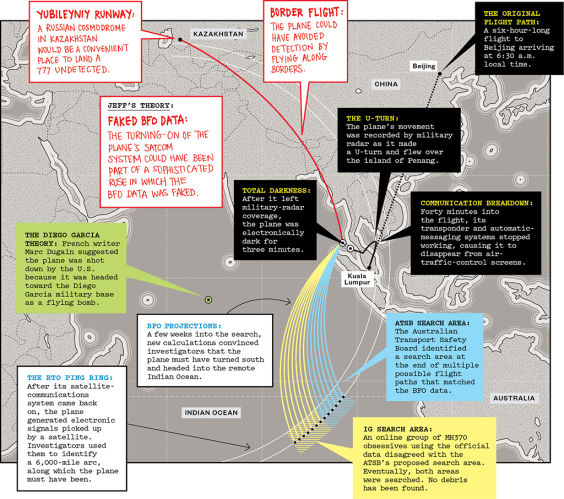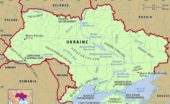Re Ian Bremmer 'Could third-party candidates upend the 2024 US election?' 3 April The current political movement in the USA…
Flight MH370 – 10 years later
Written by Diana Thebaud Nicholson // March 8, 2024 // Aviation & Aerospace // Comments Off on Flight MH370 – 10 years later
See Airline industry — Flight MH370
A post from Chris Goodfellow
“Today marks 10 years since the disappearance of MH370 – the greatest aviation enigma since Amelia Earheart. Many theories have been put forward as to the cause including my original post on Google+ that subsequently was promoted by both the Atlantic and Wired and became viral across the internet but none are conclusive to this day.
Many have asked me coming up on the tenth anniversary if my thoughts have changed. No. I still do not believe the pilot/suicide scenario.
I did many interviews during the first few months. The one on Google+ TV best expresses my thoughts and thought processes.
“On this 10th Anniversary I am posting a link [Google Plus Week 3/28/2014 w/ Former Pilot Chris Goodfellow – Former Canadian pilot Chris Goodfellow makes his first U.S. on camera appearance since his viral Google+ post about Malaysian Airlines Flight 370 to answer your questions live. Ask your questions here on YouTube or on any of the Google+ shares and we’ll see them!]
and I still have the families very much on my mind. I understand what not having closure on an important life event means and I wish the intelligence services would simply come clean with what they know. It’s time.”
NB March 2014
Fire is ‘simplest theory’ for missing Malaysian plane
Chris Goodfellow has 20 years experience as a Canadian Class-1 instrumented-rated pilot for multi-engine planes. His theory on what happened to MH370 first appeared on Google+. We’ve copyedited it with his permission.
Chris Goodfellow: A Startlingly Simple Theory About the Missing Malaysia Airlines Jet
MH370 Disappeared a Decade Ago. Here’s What We Know Today.
The disappearance of the Malaysia Airlines flight has remained one of the greatest aviation mysteries of all time. A new search may begin soon.
(NYT) Investigators searched by air and sea.
The first phase of the search lasted 52 days and was conducted largely from the air, covering 1.7 million square miles and involving 334 search flights.
In January 2017, the governments of Australia, Malaysia and China officially called off the underwater search for the plane after combing more than 46,000 square miles of the Indian Ocean floor. That effort cost $150 million.
The following January, the Malaysian government began another search in partnership with Ocean Infinity after receiving pressure from families of the missing passengers and crew. After a few months, the search effort led by Ocean Infinity ended, having found no evidence of the plane’s whereabouts.
Was any debris ever found?
While a wrecked plane was never found, about 20 pieces of debris believed to be from the plane were located along the coasts of the African mainland and on the islands of Madagascar, Mauritius, Réunion and Rodrigues.
In summer 2015, investigators determined that a large object that washed up on the shore of Réunion, a French island in the Indian Ocean, was a flaperon that had come from a Boeing 777, making it likely that it was debris from Flight 370.
Another piece of debris, a triangular piece of fiberglass composite and aluminum with the words “No Step” written on its side, was found in February 2016 on an uninhabited sandbank along the coast of Mozambique.
Then, the Australian government confirmed in September 2016 that a wing flap that had washed onto a Tanzanian island was from Flight 370. The Australian Transport Safety Bureau matched its identifying numbers to those of the missing Boeing 777.
What are the theories around the plane’s disappearance?
There are a multitude of theories, ranging from the bizarre to the provocative, about what caused the plane to disappear. In fact, there are too many to name here. The lack of information about what happened to the flight led the public and investigators in several directions.
Flight MH370 is still missing after ten years – forensic experts explain what we know and why we haven’t found the plane
Jamie Pringle, Reader in Forensic Geoscience, Keele University; Alastair Ruffell, Reader, School of Natural and Built Environment, Queen’s University Belfast; Ruth Morgan, Vice Dean Engineering (Interdisciplinarity Entrepreneurship), Professor of Crime and Forensic Science, UCL
(The Conversation, Australia) Theories abound on the flight’s disappearance and current location of the wreckage. Unusually, all communications aboard the plane were switched off shortly after take-off.
Intermittent satellite location information subsequently suggested it was flown south on a very different flight path than expected, to a remote and deep ocean area of the Southern Indian Ocean before contact was lost.
When actively searching for MH370, sophisticated international surveillance aircraft initially conducted over 300 flights to visually look for plane debris on the surface. Then surface and submersible vehicles conducted further surveys, searching over 120,000 sq km of ocean before ending the search in 2017.
Confirmed MH370 plane debris were found on Reunion Island in July 2015, and off the coast of Mozambique in February 2016, which was consistent with what we know about ocean currents. In 2018, OceanInfinity, a private exploration company, also searched 25,000 sq km but without success.
… The development of more advanced autonomous submersible vehicles may hold the key to finding MH370 in the Southern Indian Ocean, along with post-processing of raw data which can clarify what can be attributed to rocks as well as sea-floor hummocks and pockets.
This can distinguish between the sea floor and the objects being searched for. However, the area where MH370 disappeared is vast, meaning future searches will remain just as challenging as when the plane first went missing in 2014
10 years after Flight MH370 disappeared, investigators have ‘many theories but little evidence’
Air safety experts say debris analysis may eventually reveal new details, but evidence is scant
(CBC) Ten years on from when Malaysia Airlines Flight 370 vanished from the sky, the search for the truth about what happened to it continues to plague the loved ones of those on board.
“While we, the families, may have reached a settlement with our emotions, our search for answers hasn’t ended,” K S Narendran, who lost his wife, Chandrika, on the flight, said at a memorial event in Kuala Lumpur, Malaysia, last Sunday.
The disappearance of a modern commercial plane — and the 239 passengers and crew on board — has baffled experts, sparked wild conspiracy theories and triggered one of the largest searches in aviation history.
A book by retired Canadian investigator Larry Vance claims the pilot of Malaysia Airlines Flight 370 deliberately crashed into the Indian Ocean in an apparent pre-planned mass murder-suicide. It contradicts the theory of Australian air safety investigators, who believe the jet crashed into the water after it ran out of fuel, its pilots incapacitated.
2019
15 July
What Really Happened to Malaysia’s Missing Airplane
Five years ago, the flight vanished into the Indian Ocean. Officials on land know more about why than they dare to say.
William Langewiesche, a former pilot and one of the most authoritative writers on aviation, provides the most definitive—and meticulous—account of what might have happened in the flight’s final hours, and the muddied investigations from officials that followed.
(The Atlantic Magazine) “An intentional depressurization would have been an obvious way—and probably the only way—to subdue a potentially unruly cabin in an airplane that was going to remain in flight for hours to come. In the cabin, the effect would have gone unnoticed but for the sudden appearance of the drop-down oxygen masks and perhaps the cabin crew’s use of the few portable units of similar design. None of those cabin masks was intended for more than about 15 minutes of use during emergency descents to altitudes below 13,000 feet; they would have been of no value at all cruising at 40,000 feet. The cabin occupants would have become incapacitated within a couple of minutes, lost consciousness, and gently died without any choking or gasping for air. The scene would have been dimly lit by the emergency lights, with the dead belted into their seats, their faces nestled in the worthless oxygen masks dangling on tubes from the ceiling.”
See also: Exclusive: MH370 Pilot Flew a Suicide Route on His Home Simulator Closely Matching Final Flight (New York, 22 July 2016)
2018
22 May
Investigators insist MH370 crash was an accident, not a mass murder-suicide by the pilot
(WaPost) The disappearance of MH370 was a tragedy, government investigators say — but an accidental one.
Four years after MH370 vanished, the debate has reignited over what, exactly, happened to the plane.
The back-and-forth comes after a panel of aviation experts assembled by the Australian edition of “60 Minutes” posited a new theory about the final hours of the flight. The man in charge of the Australian government’s investigation has struck back, saying the “new” theory has holes of its own.
15 May
MH370 experts think they’ve finally solved the mystery of the doomed Malaysia Airlines flight
(WaPost) All but one of the 239 people on the doomed Malaysia Airlines Flight 370 had probably been unconscious — incapacitated by the sudden depressurization of the Boeing 777 — and had no way of knowing they were on an hours-long, meandering path to their deaths.
Along that path, a panel of aviation experts speculated Sunday, was a brief but telling detour near Penang, Malaysia, the home town of Captain Zaharie Ahmad Shah.
On two occasions, whoever was in control of the plane — and was probably the only one awake — tipped the craft to the left. The experts believe Zaharie, the plane’s pilot, was taking a final look.
That is the chilling theory that the team of analysts assembled by Australia’s “60 Minutes” have posited about the final hours of MH370. The conclusions have not been backed by any official findings from investigations into the mystery surrounding the March 2014 flight. But the experts on the “60 Minutes” show sought to draw the most likely scenario of the plane’s fate from the little that is known.
2 May
MH370: US team extends mission after failing to find plane in initial search zone
US company Ocean Infinity has exhausted a 25,000km ‘priority area’ identified by Australian experts as MH370’s most likely resting place
(The Guardian) The search for MH370 will enter its final phase this week, more than four years after it disappeared en route from Kuala Lumpur to Beijing.
On Monday, the CEO of Ocean Infinity, Oliver Plunkett said the company remained “absolutely determined” to find the plane.
“Whilst it’s disappointing there has been no sign of MH370 in the Australian Transport Safety Bureau search area and further north, there is still some search time remaining,” he said.
Under its contract with the Malaysian government, Ocean Infinity has 90 days – not including rest stops – to find the plane. The company will only be paid if it finds the plane, with the fee rising the longer the operation takes.
Seabed Constructor is in Fremantle for a scheduled refuelling stop, and will head out for the final leg of its search on Tuesday. The search will officially end in the coming weeks when the weather in the southern Indian Ocean worsens.
22 March
MH370 four years on: until the plane is found, theories run wild
(The Guardian) From hypoxia to a rogue pilot, there are various contenders for what happened to the Malaysia Airlines flight in March 2014
2017
3 October
Australia closed the investigation into flight MH370.
(Quartz) Australian investigators delivered their last report on the search for the aircraft, which disappeared while flying between China and Malaysia in 2014. The report said it was “almost inconceivable and certainly societally unacceptable in the modern aviation era” that the plane could not be found
MH370’s enduring mystery ‘almost inconceivable’, report says
(BBC) Their final report reiterated estimates from December and April that the Boeing 777 was most likely located 25,000 sq km (9,700 sq miles) to the north of the earlier search zone in the southern Indian Ocean.
In the report, investigators said their understanding of MH370’s location was “better now than it has ever been”.
The Australian government has said only “credible” new evidence will prompt it to resume the search.
The Malaysian government is continuing to investigate the circumstances surrounding the disappearance.
Families criticise MH370 search halt
Missing Malaysia plane MH370: What we know
2016
2 November
Malaysia Airlines Flight 370 Likely in Steep Dive Before Crash
(WSJ) Examination of a key piece of wreckage from the missing Malaysia Airlines Flight 370 has found that the aircraft was most likely in a steep dive and crashed with flaps in a retracted position, casting new doubt over theories that it was under human control.
Australian investigators overseeing the hunt for the airliner in a remote area of the Indian Ocean released a report Wednesday saying an examination of wing flap debris found off Tanzania in June showed it likely wasn’t extended when the plane entered the ocean, suggesting the aircraft wasn’t in a controlled glide with the pilot or passenger at the controls.
Investigators continue to seek answers to one of the world’s biggest aviation mysteries even as governments prepare to suspend the search after months spent scouring the floor of the southern Indian Ocean failed to find any trace of the plane.
9 June
MH370 search: New debris found on Madagascar beach
(BBC) New pieces of debris have been found in Madagascar by a man searching for parts of missing flight MH370.
Blaine Gibson, who has already found possible debris in Mozambique, made the latest discovery on the east coast of Madagascar.
One of the parts resembles an aeroplane seat part. Mr Gibson has sent images of the finds to investigators.
8 March
Where Is Flight MH370? What We Know 2 Years Later And What Remains A Mystery
Families of the 239 people on the Malaysia Airlines plane still wait for answers.
The disappearance of Malaysia Airlines flight MH370 on March 8, 2014, remains one of the biggest mysteries in aviation history.
What We Don’t Know
With so little information about what happened to the plane, the investigation hasn’t been able to determine why it happened either.
International investigators’ preferred theory is that low oxygen levels in the plane caused the crew to pass out, The Australian reported. But if the search doesn’t turn up anything, they may have re-examine other hypotheses, including that the pilot deliberately brought down the plane. Dolan, the Australian investigation chief, told The Guardian that if the plane is not found, investigators will try to reach some kind of conclusion based on the evidence they have.
Conspiracy theories abound, including suggestions that the plane was hijacked by order of Russian President Vladimir Putin, secretly diverted by the CIA to a U.S. military base in the Indian Ocean, accidentally or defensively shot down by U.S. forces in the area, hijacked by terrorists or captured by aliens.
All the unanswered questions weigh heavily on the people whose relatives were lost aboard MH370.
“For the MH370 families, this second year is just as painful, if not more painful, than the first year,” read a statement from Voice 370, a group representing the families, last week. “This absence of our loved ones is a daily reminder that we still do not have a clue about [their] fate.”
3 March
Debris Found In Mozambique Consistent With That Of Missing Malaysia Airlines Flight MH370
(Reuters) – Australia’s transportation chief said on Thursday the location of debris found on a beach in the southeast African nation of Mozambique was consistent with drift modeling related to the search for missing Malaysia Airlines flight MH370.
The debris would be the first to face thorough analysis by MH370 crash investigators as another object suspected to be part the plane’s wing has been held by French authorities since being found on Reunion Island, in the Indian Ocean, last year.
Chester added that officials will now send the meter-long piece of metal to Australia, where Australian and Malaysian officials will examine it.
American adventurer may have found Malaysia Airlines Flight MH370 debris
(AP via Global) An American adventurer said Thursday that he discovered part of an aircraft on a sandbar off the coast of Mozambique and initially thought it was from a small plane, and not from a Malaysia Airlines flight that disappeared two years ago with 239 people aboard.
If confirmed that the piece of tail section came from Flight MH370, a small piece of the puzzle will have been found, but it might not be enough to help solve one of aviation’s greatest mysteries.
2015
3 September
France: Reunion Island debris from lost flight MH370
French aviation experts have finally concluded that plane debris found on Reunion Island is from missing Malaysian Airlines flight MH370.
(CSM) The Paris Prosecutor’s Office has confirmed that plane debris found in July on a remote Indian Ocean island was from Malaysia Airlines Flight MH370 which went missing last year.
“Investigators learned Thursday that a series of numbers found inside the plane flaperon matches with records, held by a Spanish company that manufactured portions of the component, linking the debris to MH370,” CNN reports.
French investigators have been examining debris, since it was flown to an aeronautical research laboratory near Toulouse in France last month. The discovery of the flaperon on French soil mandated that France conduct an investigation under rules of the International Civil Aviation Organization.
2 August
‘Plane seat’ washed up on tiny island three months before possible MH370 jet wing found, local man says
As he carried out his daily patrol of the shores of the Indian Ocean island of Reunion, picking up debris from the black sands and giant boulders, it seemed to him like just another piece of rubbish – a bus seat, perhaps, or a hang-glider’s chair. … Ferrier had no idea of the significance of the object. Flotsam and jetsam are part of his everyday life on the inhospitable beach, where nobody dares to enter the fierce waves and shark-infested waters. …
“I found a couple of suitcases, too, around the same time, full of things,” he said, almost in passing. “I burnt them,” he said, pointing to the pile of ashes lying on the boulders. “That’s my job. I collect rubbish, and burn it. I could have found many things that belonged to the plane, and burnt them, without realizing.”
1 August
MH370 search: Debris may prove plane crashed over Indian Ocean
French aviation experts will try to establish whether the wreckage was part of the Boeing 777 that disappeared March 8, 2014, with 239 people on board
Under a microscope and expert eyes, the wing fragment that washed up on the beach of the volcanic island could yield clues not just to its path through the Indian Ocean, but also to what happened to the airplane.
30 July
Indian Ocean debris almost certainly from a Boeing 777: Malaysia
(Reuters) Malaysia is “almost certain” that plane debris found on Reunion Island in the Indian Ocean is from a Boeing 777, the deputy transport minister said on Thursday, heightening the possibility it could be wreckage from missing Flight MH370.
The object, which appeared to be part of a wing, was being sent to offices of France’s BEA crash investigation agency in Toulouse to verify if was indeed the first trace of the lost plane to be found, Malaysian Prime Minister Najib Razak said.
“The location is consistent with the drift analysis provided to the Malaysian investigation team, which showed a route from the southern Indian Ocean to Africa,” Najib said in a statement.
16 April
Flight MH370: Could it have been suicide?
(BBC) A year after the disappearance of a Malaysia Airlines plane with 239 on board, investigators still don’t know what happened. Could pilot suicide have been the cause?
“Someone was looking at Penang. Someone was taking a long, emotional look at Penang. The captain was from the island of Penang.”
There are times when Captain Simon Hardy’s analysis of flight MH370 sends shivers down the spine, especially in the light of the recent case of Germanwings Airbus flight 4U 9525.
An experienced Boeing 777 captain, he knows the Asian air routes like a commuter knows short cuts home. He flew them them for 17 years.
He’s convinced about something that no pilot, no passenger, nobody in fact wants to think is possible – that the captain of the flight, Zaharie Shah, deliberately hid the plane from radar and flew it thousands of miles off course, before it came down in the ocean.
He says the clues are in the route it took after it vanished from air traffic control. It turned back on itself and flew along the border of Malaysia and Thailand.
“It flew in and out of the countries eight times,” he says. “This is probably very accurate flying rather than just a coincidence. As both air traffic controllers in both those countries would probably assume that the aircraft was in the other country’s jurisdiction and not pay it any attention.”
2 March
MH370: ‘We cannot keep searching forever’, says Australian deputy PM
[Australian deputy prime minister] Warren Truss plays down reports that Australia was in talks with China and Malaysia about whether to call off search ‘within weeks’
Trial to push for better flight tracking a year after MH370
(Reuters) – Australia, Indonesia and Malaysia are launching a trial to allow air traffic controllers to more closely track aircraft traversing remote oceans such as the one believed to be the final resting place of Malaysia Airlines Flight MH370.
A preliminary report issued by Malaysia last May described frantic attempts to trace the aircraft, with air traffic control in Kuala Lumpur contacting counterparts in Singapore, Hong Kong and Phnom Penh when something appeared to have gone awry.
Australian Deputy Prime Minister Warren Truss said in a media release in Sunday that the new system, which adapts technology already used by most long-haul jets, could greatly narrow down search areas in the case of future tragedies.
27 February
MH370: ‘Putin ordered plane to be flown to Kazakhstan space port,’ conspiracy theory claims
26 February
One of CNN’s aviation experts thinks Putin stole missing Malaysia Airlines flight MH370
Private pilot and science writer Jeff Wise, one of CNN’s aviation analysts during the network’s wall-to-wall coverage of missing Malaysia Airlines flight MH370, has a wild theory about the plane’s true location.
23 February
Jeff Wise: How crazy am I to think I actually know where that Malaysia Airlines plane is?
In the year since the vanishing of MH370, I appeared on CNN more than 50 times, watched my spouse’s eyes glaze over at dinner, and fell in with a group of borderline-obsessive amateur aviation sleuths. A million theories bloomed, including my own.
(New York Magazine) Whether the plane went to Baikonur or elsewhere in Kazakhstan, my suspicion fell on Russia. With technically advanced satellite, avionics, and aircraft-manufacturing industries, Russia was a paranoid fantasist’s dream. (The Russians, or at least Russian-backed militia, were also suspected in the downing of Malaysia Flight 17 in July.) Why, exactly, would Putin want to steal a Malaysian passenger plane? I had no idea. Maybe he wanted to demonstrate to the United States, which had imposed the first punitive sanctions on Russia the day before, that he could hurt the West and its allies anywhere in the world. Maybe what he was really after were the secrets of one of the plane’s passengers. Maybe there was something strategically crucial in the hold. Or maybe he wanted the plane to show up unexpectedly somewhere someday, packed with explosives. There’s no way to know. That’s the thing about MH370 theory-making: It’s hard to come up with a plausible motive for an act that has no apparent beneficiaries.
As it happened, there were three ethnically Russian men aboard MH370, two of them Ukrainian-passport holders from Odessa. Could any of these men, I wondered, be special forces or covert operatives? As I looked at the few pictures available on the internet, they definitely struck me as the sort who might battle Liam Neeson in midair. …
Last month, the Malaysian government declared that the aircraft is considered to have crashed and all those aboard are presumed dead. Malaysia’s transport minister told a local television station that a key factor in the decision was the fact that the search mission for the aircraft failed to achieve its objective. Meanwhile, new theories are still being hatched. One, by French writer Marc Dugain, states that the plane was shot down by the U.S. because it was headed toward the military bases on the islands of Diego Garcia as a flying bomb. …
The search failed to deliver the airplane, but it has accomplished some other things: It occupied several thousand hours of worldwide airtime; it filled my wallet and then drained it; it torpedoed the idea that the application of rationality to plane disasters would inevitably yield ever-safer air travel. And it left behind a faint, lingering itch in the back of my mind, which I believe will quite likely never go away.

30 January
Missing Malaysia plane MH370: What we know
(BBC) The Malaysian government has officially declared the disappearance of Malaysian Airlines flight MH370, en route from Kuala Lumpur to Beijing on 8 March 2014, an accident.
29 January
MH370: Six ‘reasons’ why plane vanished
(Telegraph UK) Conspiracy theories have flourished in the six-month-old Malaysia Airline mystery, from the sinister to the far-fetched.
2014
18 March 2014
Chris Goodfellow: A Startlingly Simple Theory About the Missing Malaysia Airlines Jet
(Wired) We old pilots were drilled to know what is the closest airport of safe harbor while in cruise. Airports behind us, airports abeam us, and airports ahead of us. They’re always in our head. Always. If something happens, you don’t want to be thinking about what are you going to do–you already know what you are going to do. When I saw that left turn with a direct heading, I instinctively knew he was heading for an airport. He was taking a direct route to Palau Langkawi, a 13,000-foot airstrip with an approach over water and no obstacles. The captain did not turn back to Kuala Lampur because he knew he had 8,000-foot ridges to cross. He knew the terrain was friendlier toward Langkawi, which also was closer.
Take a look at this airport on Google Earth. The pilot did all the right things. He was confronted by some major event onboard that made him make an immediate turn to the closest, safest airport.
For me, the loss of transponders and communications makes perfect sense in a fire. And there most likely was an electrical fire. In the case of a fire, the first response is to pull the main busses and restore circuits one by one until you have isolated the bad one. If they pulled the busses, the plane would go silent. It probably was a serious event and the flight crew was occupied with controlling the plane and trying to fight the fire. Aviate, navigate, and lastly, communicate is the mantra in such situations.



